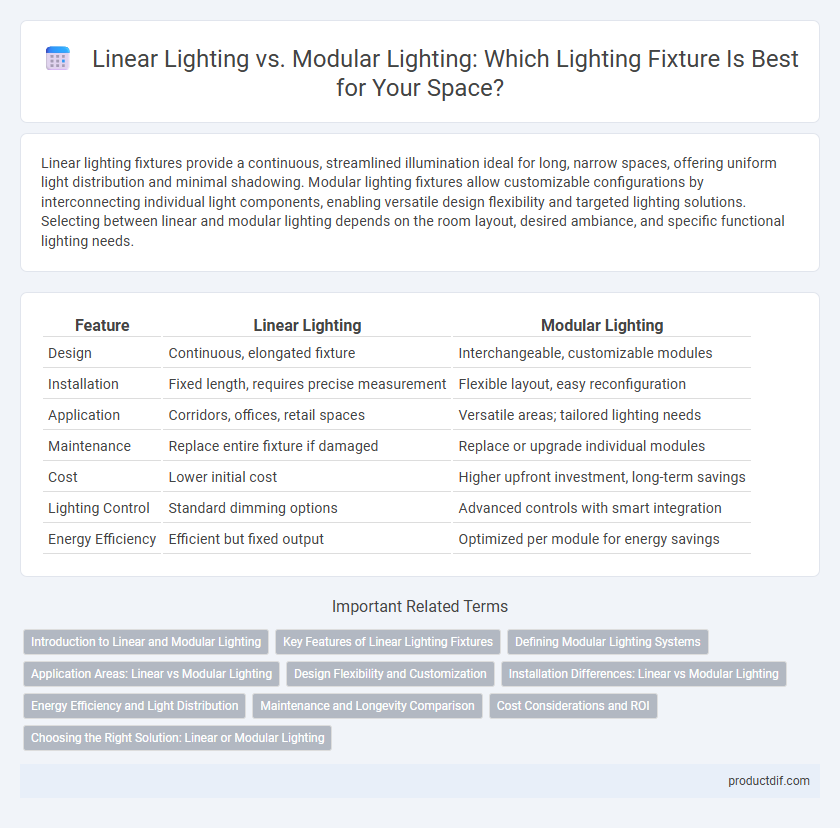Linear lighting fixtures provide a continuous, streamlined illumination ideal for long, narrow spaces, offering uniform light distribution and minimal shadowing. Modular lighting fixtures allow customizable configurations by interconnecting individual light components, enabling versatile design flexibility and targeted lighting solutions. Selecting between linear and modular lighting depends on the room layout, desired ambiance, and specific functional lighting needs.
Table of Comparison
| Feature | Linear Lighting | Modular Lighting |
|---|---|---|
| Design | Continuous, elongated fixture | Interchangeable, customizable modules |
| Installation | Fixed length, requires precise measurement | Flexible layout, easy reconfiguration |
| Application | Corridors, offices, retail spaces | Versatile areas; tailored lighting needs |
| Maintenance | Replace entire fixture if damaged | Replace or upgrade individual modules |
| Cost | Lower initial cost | Higher upfront investment, long-term savings |
| Lighting Control | Standard dimming options | Advanced controls with smart integration |
| Energy Efficiency | Efficient but fixed output | Optimized per module for energy savings |
Introduction to Linear and Modular Lighting
Linear lighting features continuous, elongated light sources designed for seamless illumination along corridors, workspaces, or retail environments, enhancing spatial perception and aesthetics. Modular lighting consists of customizable, individual light units that can be configured and interconnected to create varied lighting patterns suited for flexible architectural designs and targeted lighting needs. Both systems optimize energy efficiency and visual comfort, with linear lighting emphasizing uniformity and modular lighting prioritizing adaptability.
Key Features of Linear Lighting Fixtures
Linear lighting fixtures offer continuous, uniform illumination ideal for creating sleek, modern aesthetics in commercial and residential spaces. Key features include seamless integration with architectural elements, energy-efficient LED technology, and customizable lengths to fit various design requirements. These fixtures provide glare-free, evenly distributed light, enhancing visual comfort and spatial perception.
Defining Modular Lighting Systems
Modular lighting systems consist of interconnected components that can be easily customized, expanded, or reconfigured to meet specific design requirements. Unlike linear lighting, which typically involves fixed, elongated fixtures, modular systems offer flexible layouts and diverse shapes, enhancing adaptability in various architectural spaces. This adaptability makes modular lighting ideal for dynamic environments requiring frequent adjustments or personalized lighting solutions.
Application Areas: Linear vs Modular Lighting
Linear lighting is ideal for continuous illumination in corridors, offices, and retail spaces, providing uniform light distribution and seamless design integration. Modular lighting offers flexibility for dynamic layouts such as exhibition areas, industrial workstations, and customized architectural installations, enabling targeted lighting and easy reconfiguration. Both systems enhance spatial aesthetics but differ in adaptability, with linear lighting suited for consistent, extended runs and modular lighting excelling in versatile, segmented applications.
Design Flexibility and Customization
Linear lighting offers streamlined, continuous illumination ideal for sleek, minimalist designs, providing consistent light distribution across long spans. Modular lighting allows for greater design flexibility and customization, enabling configurations of various shapes and sizes to fit complex architectural layouts and specific functional needs. Combining both systems can enhance spatial ambiance while addressing diverse lighting requirements with precision.
Installation Differences: Linear vs Modular Lighting
Linear lighting fixtures feature continuous, elongated designs that simplify installation by allowing direct mounting along surfaces with minimal connectors. Modular lighting systems consist of individual, interchangeable units that require flexible connection points and custom layout configurations during installation. The choice between linear and modular lighting affects installation time, complexity, and adaptability to unique architectural layouts.
Energy Efficiency and Light Distribution
Linear lighting systems offer consistent energy efficiency through streamlined, continuous LED strips that minimize power consumption while providing uniform light distribution across large spaces. Modular lighting fixtures enable customizable configurations that optimize energy use by targeting specific areas and adjusting output levels, enhancing overall lighting control and reducing waste. Both systems improve energy performance, but linear lighting excels in delivering even illumination, whereas modular lighting provides adaptable light distribution tailored to dynamic spatial requirements.
Maintenance and Longevity Comparison
Linear lighting fixtures typically offer easier maintenance due to their continuous design, allowing for simpler access and fewer individual components to manage. Modular lighting systems feature replaceable modules, which can reduce downtime by enabling targeted repairs without replacing the entire fixture, potentially extending overall system longevity. Both types benefit from LED technology, though modular setups may provide enhanced serviceability, resulting in longer effective lifespans under heavy use scenarios.
Cost Considerations and ROI
Linear lighting typically offers lower upfront costs and easier installation compared to modular lighting systems, making it a cost-effective choice for straightforward projects. Modular lighting, while requiring higher initial investment, provides enhanced flexibility and scalability, resulting in better long-term ROI through reduced maintenance and adaptability to changing design needs. Evaluating project scale, maintenance expenses, and future adaptability is crucial for optimizing cost efficiency and maximizing return on investment.
Choosing the Right Solution: Linear or Modular Lighting
Linear lighting offers a continuous, uniform illumination ideal for long hallways and open office spaces, enhancing visual comfort with minimal shadowing. Modular lighting provides versatile options with customizable components, suitable for dynamic environments requiring tailored light zones or design flexibility. Selecting the right solution depends on spatial layout, desired ambience, and application-specific lighting needs to maximize energy efficiency and aesthetic impact.
Linear lighting vs Modular lighting Infographic

 productdif.com
productdif.com